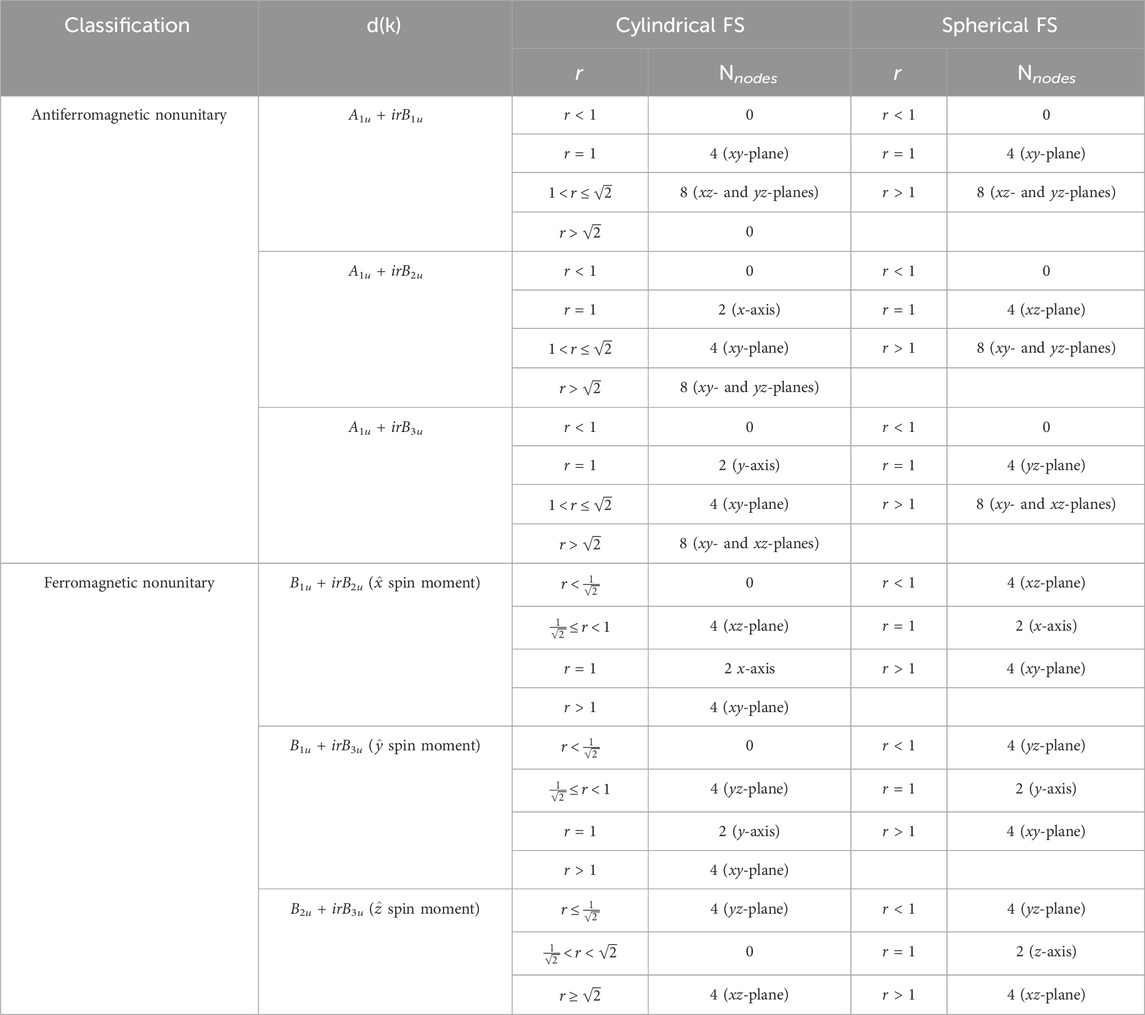- Department of Physics, University of Florida, Gainesville, FL, United States
Considerable evidence shows that the heavy fermion material UTe2 is a spin-triplet superconductor, possibly manifesting time-reversal symmetry breaking, as measured by Kerr effect below the critical temperature, in some samples. Such signals can arise due to a chiral orbital state or possible nonunitary pairing. Although experiments at low temperatures appear to be consistent with point nodes in the spectral gap, the detailed form of the order parameter and even the nodal positions are not yet determined. Thermal conductivity measurements can extend to quite low temperatures, and varying the heat current direction should be able to provide information on the order parameter structure. Here, we derive a general expression for the thermal conductivity of a spin-triplet superconductor and use it to compare the low-temperature behavior of various states proposed for UTe2.
1 Introduction
The uranium-based superconductor UTe2 has stimulated a large number of experimental and theoretical studies, initially because of its apparent role as a paramagnetic end point of a family of ferromagnetic superconductors [1–3] and later as evidence for spin-triplet superconductivity accumulated. The nuclear magnetic resonance (NMR) Knight shift measurements on the earlier samples did not show any change in the superconducting state [4], although recent Knight shift measurements on high-quality samples show a small reduction along all three axes [5]. Both measurements support spin–triplet pairing; however, the spin structure of Cooper pairs remains unclear. Another piece of evidence that indicates spin–triplet pairing is the size of the upper critical field Hc2 that exceeds the Pauli limit for all field directions [1, 6]. Measured power–law temperature dependence in NMR relaxation, specific heat [1], and thermal conductivity [7, 8] was found to be consistent with point nodes, as expected for a triplet superconductor in a system with strong spin–orbit coupling (SOC) [9–11]. Finally, a reentrant superconducting phase was shown to be stabilized at high magnetic fields [12].
A second set of measurements relevant to the nature of the superconducting state purports to exhibit evidence for time-reversal symmetry breaking (TRSB) below Tc, suggesting that UTe2 may support the long-sought chiral p-wave state that may serve as a quantum computing platform [13–17]. Initially, the polar Kerr effect [18] experiments suggested that TRSB occurred in the superconductor, implying the existence of a multicomponent spin-triplet order parameter. According to group theoretical classifications of the one-dimensional (1D) irreducible representations (irreps) allowed in orthorhombic symmetry, order parameters corresponding to single irreps must be unitary triplet states, meaning that any TRSB must arise from a nonunitary multicomponent state. Such combinations of 1D representations were discussed intensively, particularly because a double specific heat transition was sometimes observed in early samples, recalling the specific heat experiments in multicomponent UPt3.
More recently, measurements of a new generation of high-quality UTe2 crystals grown in molten salt flux have challenged this characterization of UTe2 as a chiral triplet state breaking time-reversal symmetry (TRS). The Kerr effect was observed in a sample showing two specific heat jumps, but as the quality of the samples improved, only a single transition was observed [19, 20]. A recent investigation of the Kerr effect on both the old- and new-generation UTe2 single crystals displaying a single specific heat jump found no evidence for TRSB superconductivity [21]. Similarly, muon spin relaxation (μSR) measurements of the molten salt flux-grown samples found no evidence of TRSB [22]. Finally, sound velocity changes across Tc [23] and recent NMR Knight shift measurements on similar samples [5] both point to a single-component, odd parity-order parameter, i.e., inconsistent with the previous hypothesis of nonunitary pairing.
The thermal conductivity κ(T) is an important probe of the gap structure of unconventional superconductors, reflecting the ability of the superconductor to carry heat current in various directions. The theory of thermal conductivity in unitary triplet superconductors is quite similar to the well-known theory developed for singlet superconductors [24, 25]. Most of the popular model triplet states in the literature, including the 3He-A phase, belong to this class. In that case, the triplet quasiparticle energies are
In this paper, we derive a general form of the thermal conductivity of a triplet superconductor in the presence of nonmagnetic pointlike impurities and evaluate it for various types of triplet states that have been proposed for UTe2. The aim is to see whether there are qualitative distinctions between the thermal conductivity temperature and heat current direction dependence of unitary and nonunitary states and whether or not predictions of low-temperature behavior can be used, by comparison with experiments, to identify the ground state of UTe2.
2 Model and formalism
2.1 Superconducting state
In a general triplet superconductor, the spin structure of the superconducting order parameter is constrained by the underlying crystal symmetries. The structure of the UTe2 crystals corresponds to the orthorhombic point group D2h, and the symmetry of the odd-parity pairing states can be deduced according to the irreducible representations of the D2h point group [30–32]. Table 1 shows the odd-parity triplet superconducting states considered in this article. Here, we do not consider the even-parity states for the D2h point group, and we further assume strong SOC due to heavy atoms like U and Te. Due to strong SOC, orbital and spin degrees of freedom do not transform independently; instead, each space group rotation involves a rotation in spin and spatial spaces of the order parameter. In the weak SOC limit, the odd-parity states for the D2h point group come with line nodes that are not consistent with experimental measurements.
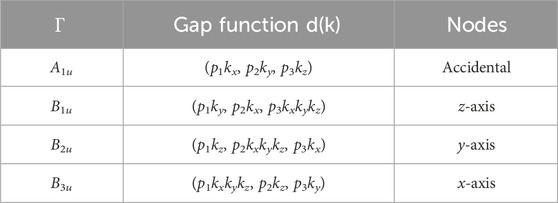
Table 1. List of possible spin-triplet superconducting states for an orthorhombic crystal with strong spin–orbit coupling. Here, pi=1,..,3 are constants, and ∀pi ∈ R.
The d-vector is real for the superconducting states listed in Table 1; hence, these states preserve TRS. These states are unitary triplet states, i.e.,  and a 4 × 4 matrix in the Nambu-spin space with
and a 4 × 4 matrix in the Nambu-spin space with  . A TRSB state is not possible with a single-component order parameter, noting that the D2h group has only one-dimensional irreducible representations. We construct the TRSB superconducting state with a combination of two irreducible representations, and all such possible combinations are shown in Table 2. In principle, a combination of two different irreducible representations involves six real constants; however, we introduce a single-parameter model for the TRSB states. The effective d-vector is
. A TRSB state is not possible with a single-component order parameter, noting that the D2h group has only one-dimensional irreducible representations. We construct the TRSB superconducting state with a combination of two irreducible representations, and all such possible combinations are shown in Table 2. In principle, a combination of two different irreducible representations involves six real constants; however, we introduce a single-parameter model for the TRSB states. The effective d-vector is
In the Nambu-spin basis, the mean field Hamiltonian reads
where ξk is the electronic dispersion, Δ0 is the superconducting gap energy scale, and σ0 is the identity matrix in the spin space. We adopt a model where the electronic dispersion reads
where ma/b is the effective masses along
Here, ω is the quasiparticle energy. The Matsubara Green’s function can be obtained by ω → iωn. The 2 × 2 matrices in the spin space are
Here, q = i (d ×d*), and the denominator D is
Here, we introduce
2.2 Impurity scattering and thermal transport
In order to calculate the thermal conductivity, we need to include the effect of impurity scattering that dominates all other relaxation mechanisms at low temperatures. We consider elastic impurity scattering due to pointlike defects and include its effect through a disorder-averaged self-energy. The impurity self-energy is calculated within the self-consistent T-matrix approximation. The momentum-integrated Green’s function
and the anomalous Green’s functions
where δs ≡ tan−1 (πN0Vimp) is the s-wave scattering phase shift; Γu = nimp/(πN0); and nimp and Vimp are the impurity concentration and impurity potential, respectively. Here,
Here, impurity-renormalized
where
Here,
For the unitary states, the nodes are symmetry-imposed, and for the nonunitary states, nodes may shift away from the high-symmetry directions, and their positions remain protected against disorder as long as the Σ component of the impurity self-energy vanishes. Σ can be interpreted as impurity-induced magnetization. For the chiral states, this term remains finite and gives rise to non-degenerate quasiparticle spin density and, in principle, can change the nodal positions. Here, the nodes do not refer to the zeros of the gap or the order parameter; instead, they are the zeros in the quasiparticle spectrum on the Fermi surface. In the unitary states, the gap nodes and the spectral nodes are same, unlike the nonunitary states. There are some additional triplet terms Σ ⋅σ and (Σ ×d) ⋅σ in Eq. 20, which reflect the impurity-induced modification of the spin structure of the Cooper pairs. It is worth mentioning that there is an impurity-induced odd-frequency pairing for the chiral nonunitary states, which is spin singlet and odd parity in nature.
After obtaining the impurity-dressed Green’s function, we calculate the electronic thermal conductivity κ using the Kubo formula that relates the thermal conductivity to the heat–current response [24]. We ignore the vertex corrections and restrict ourselves to the bare thermal–current response function. The vertex corrections are small in the strong scattering limit that is focused on in this article [33]. The diagonal thermal conductivity for a general triplet superconductor reads
Here,
where
3 Results and discussion
3.1 T = 0 limit of the density of states and thermal conductivity
We start with the single-component states based on four irreducible representations of the D2h point group symmetry. The basis functions for these four states are listed in Table 1, where the A1u state remains gapped unless the coefficient of one of the basis functions is set to zero. We exclude that possibility and choose the same coefficients for all three basis functions, and this choice of coefficients is adopted for the other states as well, which is a reasonable choice for a qualitative understanding of the low-energy properties. In principle, it is also possible to generate line nodes with an appropriate choice of basis function coefficients, but those possibilities are excluded considering the recent experimental results on UTe2. Apart from the A1u state, the B1u state also remains gapped because the open Fermi surface along the
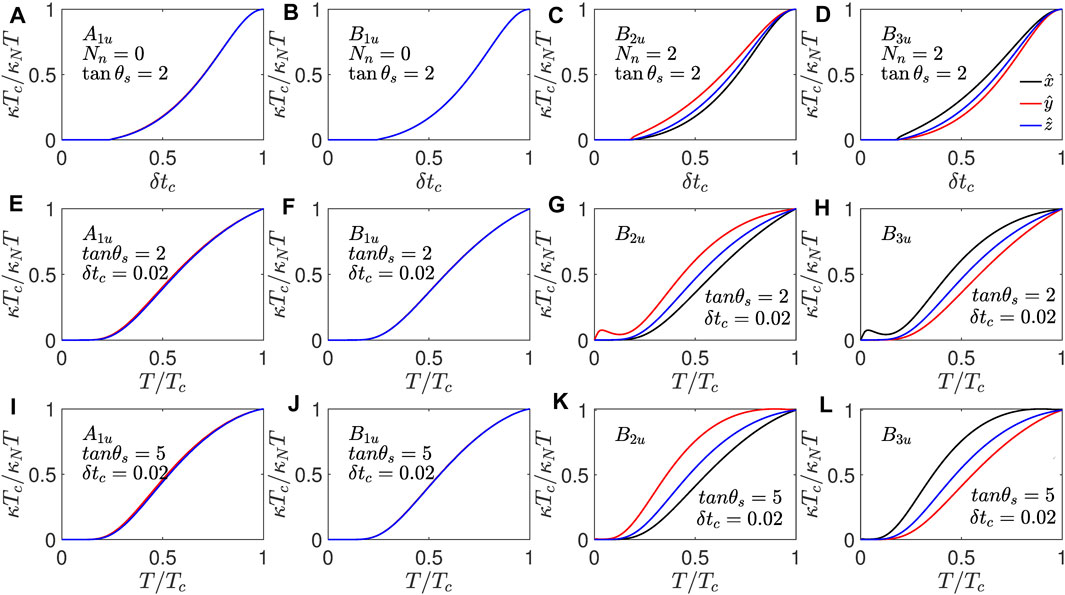
Figure 1. Thermal conductivity for the single-component unitary states allowed by the D2h point group. The thermal conductivity normalized to its value at Tc for the four irreducible representations of the D2h point group shown column-wise for the A1u, B1u, B2u, and B3u representations from (A–D), respectively. The first row shows the residual thermal conductivity in the zero-temperature limit as a function of relative reduction in the transition temperature δtc. (E–H) in the second row show κTc/κNT for the weak scatterers with tan θs = 2 and for the intermediate-strength scatterers with tan θs = 5 from (I–L) in the third row. For the temperature dependence, the Tc is reduced by 2% (δtc = 0.02) with respect to the clean limit.
It is useful to examine the density of states (DOS) and the structure of the low-energy quasiparticle states before discussing the thermal transport for the nonunitary states. We first report the average density of states per spin for the nonunitary states on a cylindrical Fermi surface that is open along the
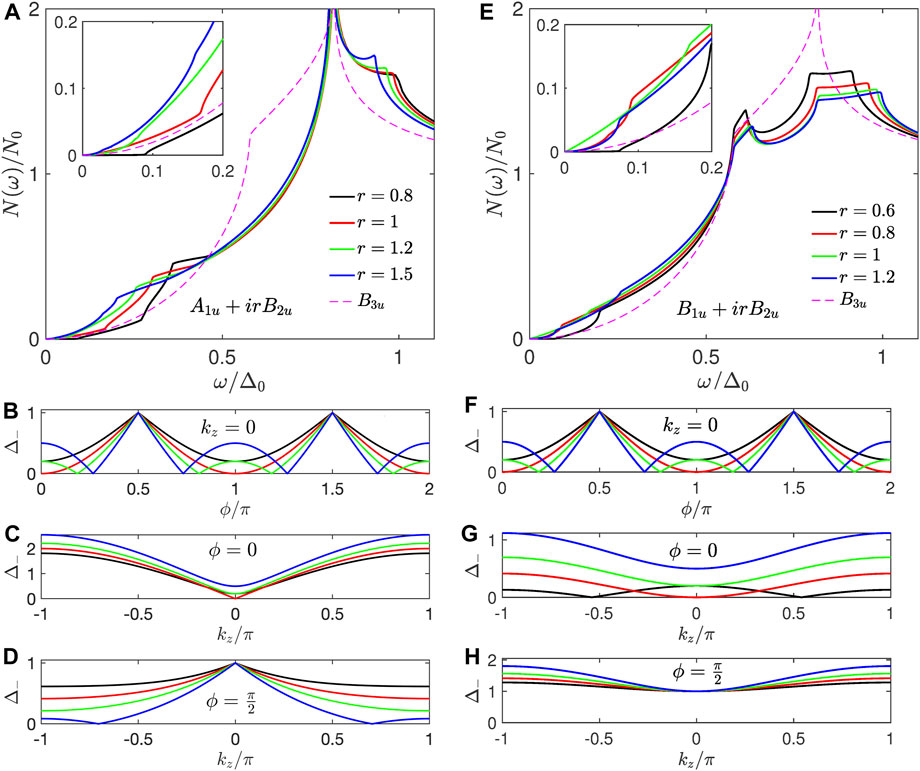
Figure 2. Density of states: (A) shows the density of states (DOS) per spin for the A1u + irB2u state for different values of the mixing parameter r. The inset shows the energy dependence of the DOS at low energies. A dashed line illustrating the DOS for the unitary B3u state is shown for comparison. (B–D) show the variation in Δ− for different values of r in the xy, xz, and yz-planes, respectively. (E) shows the DOS per spin for the B1u + irB2u state, and Δ− in the xy, xz, and yz-planes is shown in panels (F–H), respectively.
Next, we consider the ferromagnetic nonunitary states on the cylindrical Fermi surface, which are chiral states with finite Cooper pair spin moment. Figure 2D shows the DOS for the B1u + irB2u state along with the Δ− in Figures 2E–F. This state is gapped for
We now discuss the zero-temperature limit of the thermal conductivity, which is very sensitive to the gap structure. We compare the normalized κTc/TκN along three principal directions, where the thermal conductivity along a particular direction is normalized to its normal state value at Tc along that direction. This suppresses the intrinsic anisotropy present in the electronic structure and accentuates the effect of order parameter anisotropy. Figures 3A–D show κTc/TκN in the zero-temperature limit for the A1u + irB1u state as a function of the relative reduction in the transition temperature δTc. For a weakly disordered system, κ/T vanishes in the zero-temperature limit, but as the disorder level increases and crosses Γth, κ/T|T→0 becomes finite and reaches the normal-state value as the superconductivity vanishes. For the A1u + irB1u state, κTc/κNT shows isotropic behavior in the xy-plane. Note that for this state, the nodes are always along the
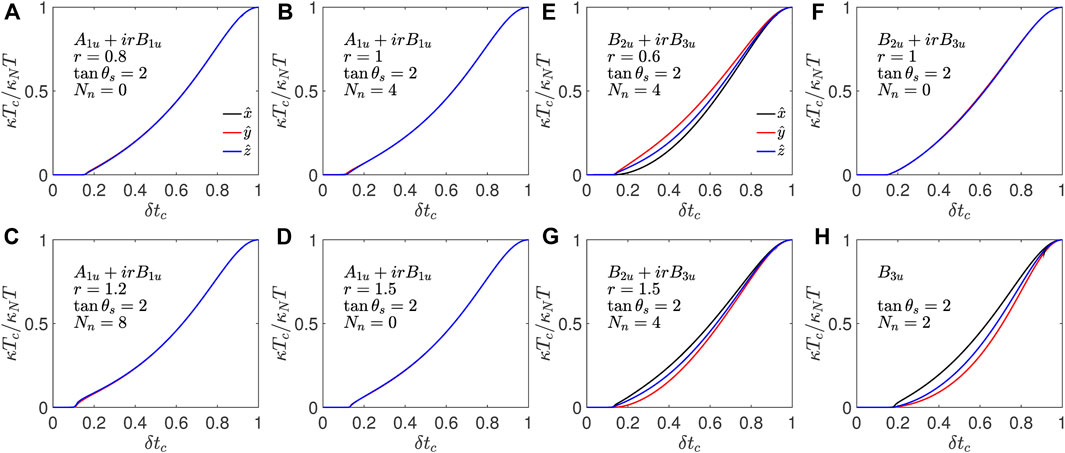
Figure 3. Residual thermal conductivity. Zero-temperature limit κTc/κNT for the A1u + irB1u in (A–D) and for the B2u + irB3u state in (E–G) for various values of mixing parameter r. (H) shows κTc/κNT|T→0 for the unitary B3u state. The s-wave scattering phase shift is θs = tan−1 (2) for all the panels. The number of nodes Nn is indicated for each case.
Next, we look at the zero-temperature limit thermal conductivity for the A1u + irB2u state for two different impurity potential strengths. Figures 4A–D show κTc/κNT for s-wave scattering phase shift tan−1 (2), and panels Figures 4E–H show κTc/κNT for θs = tan−1 (5). κ/T|T→0 becomes finite above a threshold disorder level, as in earlier cases. This threshold scattering rate is smaller for the stronger impurity potentials. This state has a minimum and maximum along the xz-plane, the energy gap is small in the yz-plane, and a weak maximum exists along the
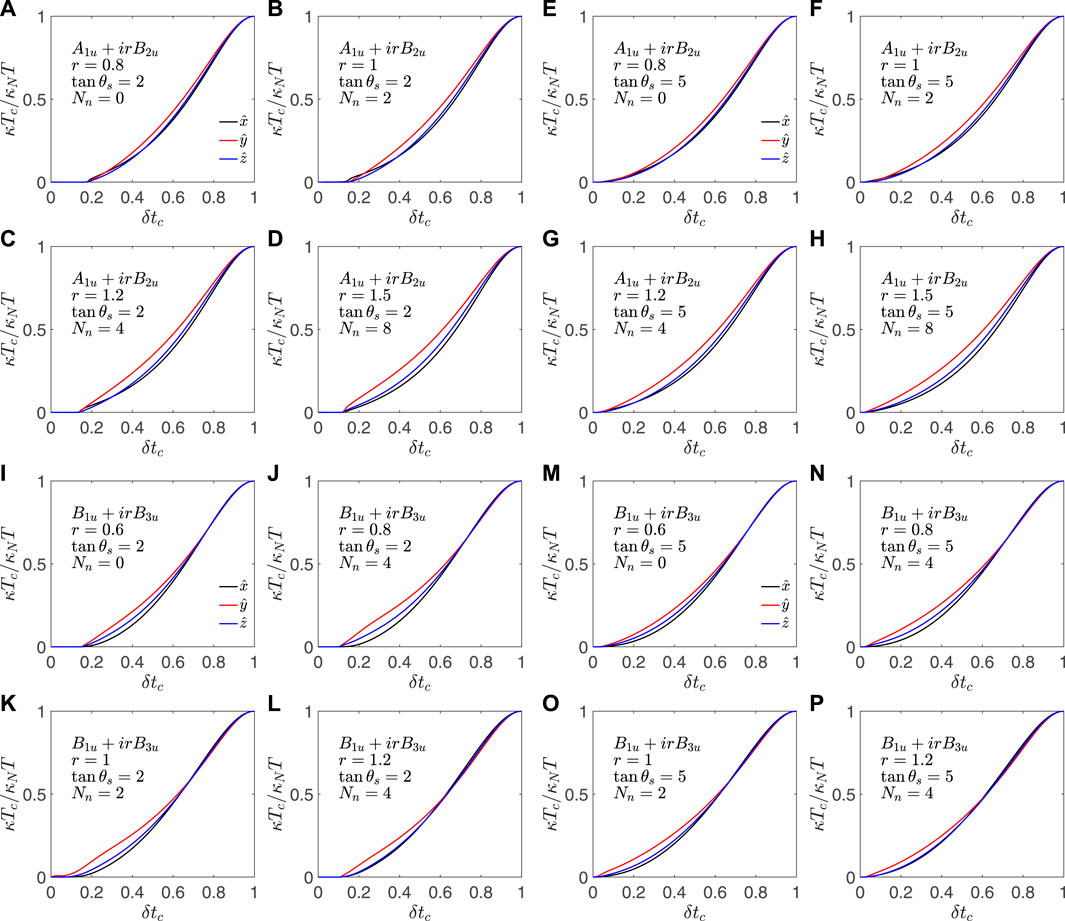
Figure 4. Residual thermal conductivity: (A–H) show κ/T in the zero-temperature limit normalized to κN/T at Tc as a function of relative Tc reduction δtc for the A1u + irB2u state for different values of the mixing parameter r. The s-wave scattering phase for (A–D) is θs = tan−1 (2) and for panels (E–H) is θs = tan−1 (5). For the B2u + irB3u state, κTc/κNT|T→0 is shown for various values of parameter r for the s-wave scattering phase shift θs = tan−1 (2) in (I–L) and with θs = tan−1 (5) in (M–P). The number of nodes Nn is indicated for each case.
For the B1u + irB3u state, in the gapped phase, i.e.,
3.2 Finite T electronic thermal conductivity
Now, we look at the temperature evolution of the normalized thermal conductivity for the nonunitary states. At very low temperatures, the elastic scattering by the impurities is the main mechanism of relaxation. However, as the temperature increases, the inelastic scattering also becomes important, which we discuss in the subsequent section. Apart from the electron contribution to thermal conductivity, phonon thermal conductivity can also become significant. Here, we focus on electronic thermal conductivity and the effect of impurity scattering on it and the effect of underlying spectral nodes on the anisotropy in the thermal conductivity. As shown in Figure 1, the thermal conductivity shows a weak maximum as a function of temperature at very low temperatures along the nodal directions. There is no evidence for such a feature in the experimental measurements [7, 34]; therefore, we set θs = tan−1 (5) for the rest of our discussion (see Supplementary Material for the weaker impurity scatterers). We first consider the A1u + irB1u state, which shows very isotropic residual thermal conductivity, and the thermal conductivity remains isotropic as a function of temperature, as shown in Figures 5A–D. For the clean system with δtc = 0.02, at very low temperatures, the thermal conductivity remains negligibly small, and as the temperature increases, κ/T increases T2 at very low temperatures. This behavior is observed for both nodal and gapped systems. Note that in superconductors with point nodes, there are very few states available at the Fermi energy, as shown in Figure 2. For dirtier systems such as δtc = 0.15, there are sufficient quasiparticle states at the Fermi level to provide nonzero thermal conductivity, which is depicted in Figures 5E–H. At low temperatures, κ/T remains independent of temperature, and as it increases, once more, quasiparticles become relevant for transport as the temperature increases.
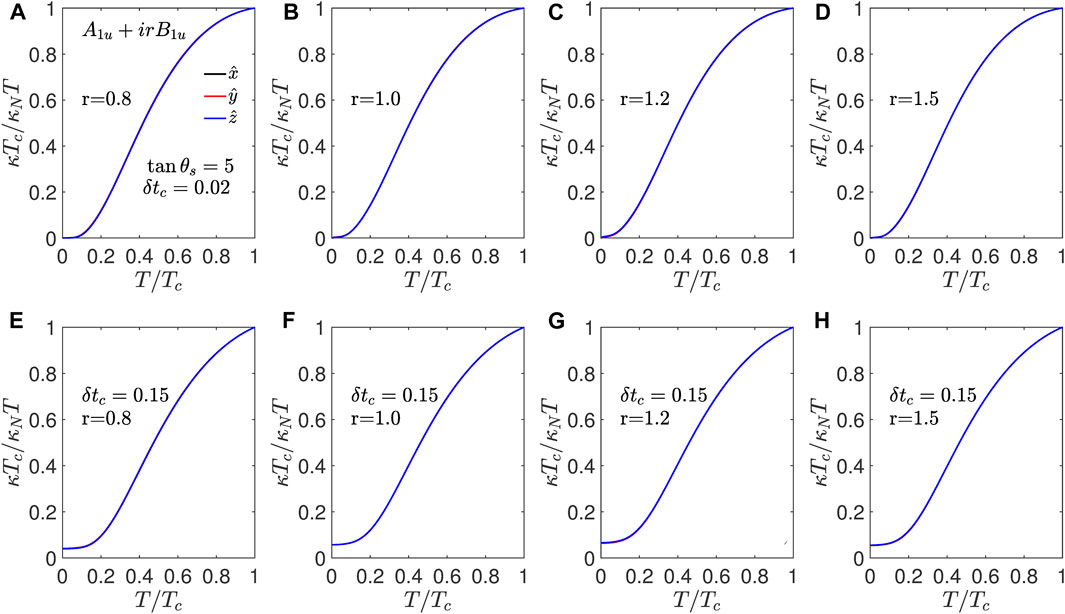
Figure 5. A1u + irB1u: Thermal conductivity normalized to its normal state value at Tc for A1u + irB1u shown as a function of temperature normalized to Tc for scatterers with tan θs = 5 for δtc = 0.02 from (A–D) and for δtc = 0.15 in (E–H) for various values of mixing parameter r.
Next, we consider the A1u + irB2u state, which shows enhanced thermal conductivity along the
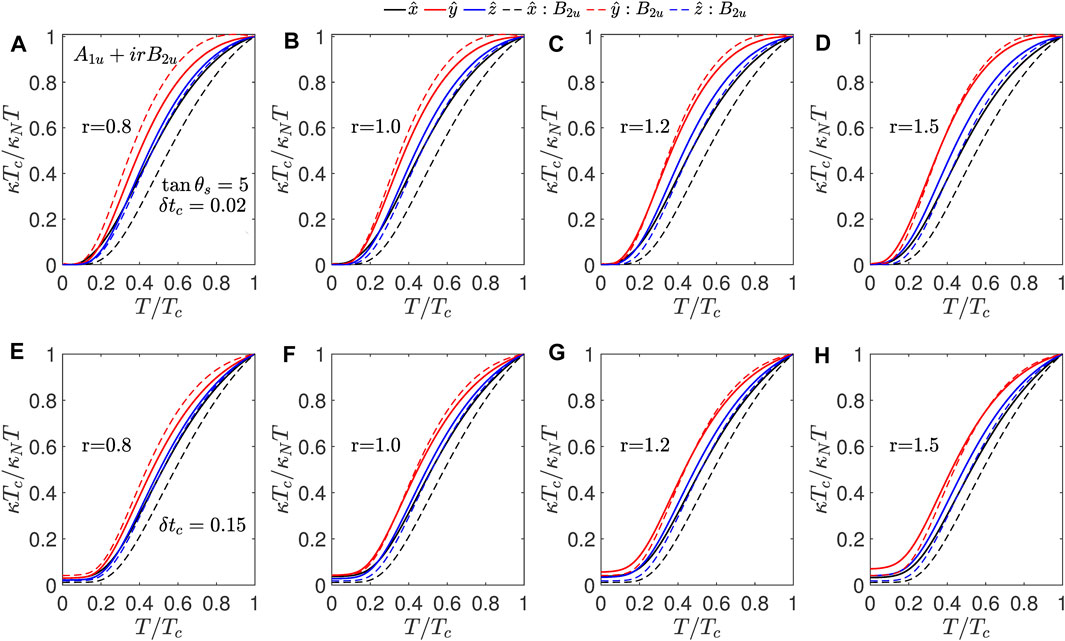
Figure 6. A1u + irB2u: Thermal conductivity normalized to its normal state value at Tc for A1u + irB2u shown as a function of temperature normalized to Tc for scatterers with tan θs = 5 for δtc = 0.02 from (A–D) and for δtc = 0.15 in (E–H) for various values of mixing parameter r. The dashed lines show the normalized thermal conductivities for the B2u state with the same impurity parameters.
Next, we consider the B2u + irB3u state, which is one of the FM nonunitary chiral states. For this state, there are four point nodes in the yz-plane for
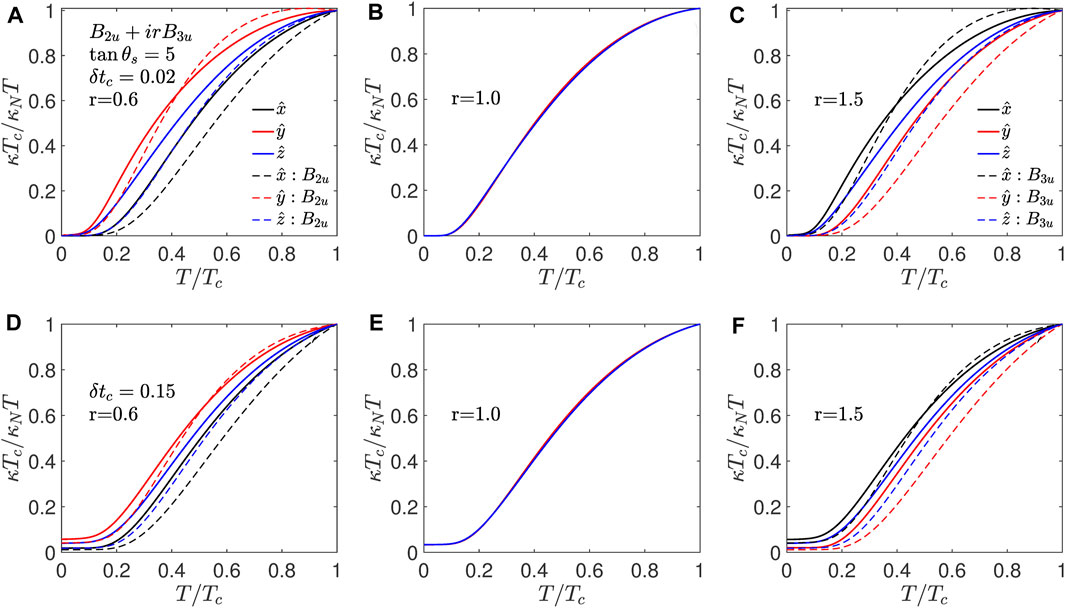
Figure 7. B2u + irB3u: Thermal conductivity normalized to its normal state value at Tc for B2u + irB3u shown as a function of temperature normalized to Tc for scatterers with tan θs = 5 for δtc = 0.02 from (A–C) and for δtc = 0.15 in (D–F) for various values of mixing parameter r. The dashed lines show the normalized thermal conductivities for the B2u state in (A,D) and for the B3u state in (C,F). The impurity parameters are the same for the single-component superconducting states.
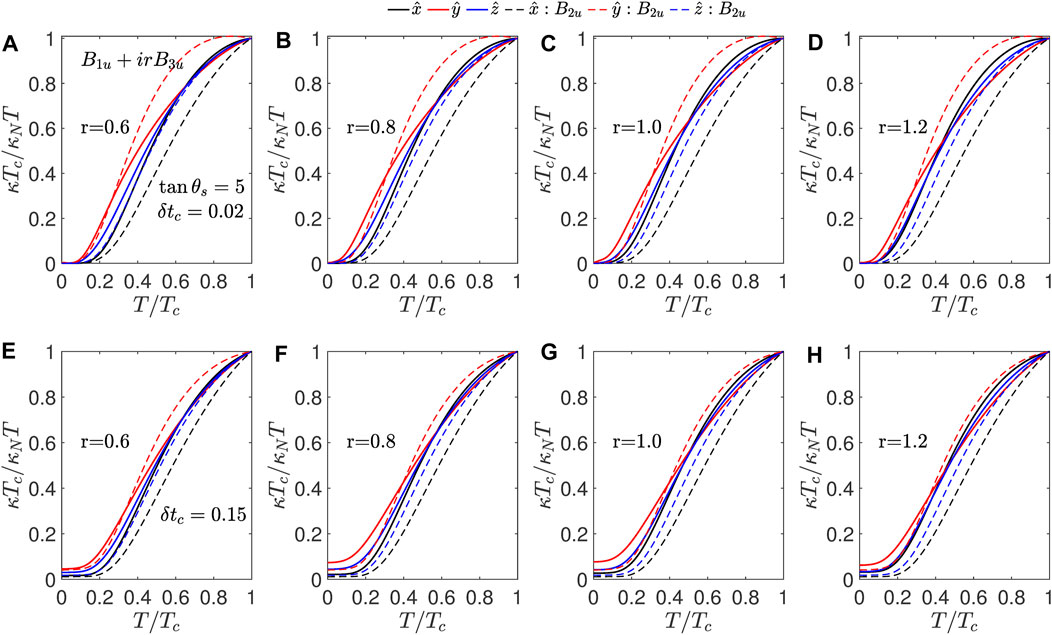
Figure 8. B1u + irB3u: Thermal conductivity normalized to its normal state value at Tc for B1u + irB3u shown as a function of temperature normalized to Tc for scatterers with tan θs = 5 for δtc = 0.02 from (A–D) and for δtc = 0.15 in (E–H) for various values of mixing parameter r. The dashed lines show the normalized thermal conductivities for the B2u state with same impurity parameters.
3.3 Inelastic scattering effects
As mentioned in the previous section, at very low temperatures, i.e., T ≪ Tc, the elastic scattering from impurities is the only mechanism that determines the scattering rate. However, at higher temperature, inelastic scattering from a bosonic mode is possible. We consider a simple scenario where there is a dispersionless bosonic mode that couples with the fermions with an effective coupling constant gfb. We further assume that the coupling does not depend on the spin degree of freedom of the fermion. The lowest-order self-energy for the fermions reads
Here, D is the bosonic Green’s function and ωn and Ωm are the fermionic and bosonic Matsubara frequencies, respectively. After performing the Matsubara summation, we obtain
Here, the real part of the self-energy contributes to mass renormalization, and the imaginary part modifies the scattering rate, which is a function of quasiparticle energy and temperature. Noting that UTe2 has very high effective mass, we ignore the real part of the self-energy. The imaginary part of the self-energy is
where
Since the thermal response integrand is peaked at ω = 0, we only retain the temperature dependence of the inelastic self-energy at ω = 0. At very low temperatures, the inelastic scattering rate behaves likes T4 for the point nodes and T3 for the line nodes in the static limit. This is sufficient to understand the qualitative effect of inelastic scattering. The prefactor in Eq. 33 is fixed by the value of the inelastic scattering rate at Tc.
Figure 9 shows the effect of inelastic scattering on the electronic thermal conductivity. We show the results for two cases as the rest of the cases are qualitatively similar. The first row of Figures 9A–D shows the normalized thermal conductivity for the A1u + irB2u state, which shows enhanced thermal conductivity along the
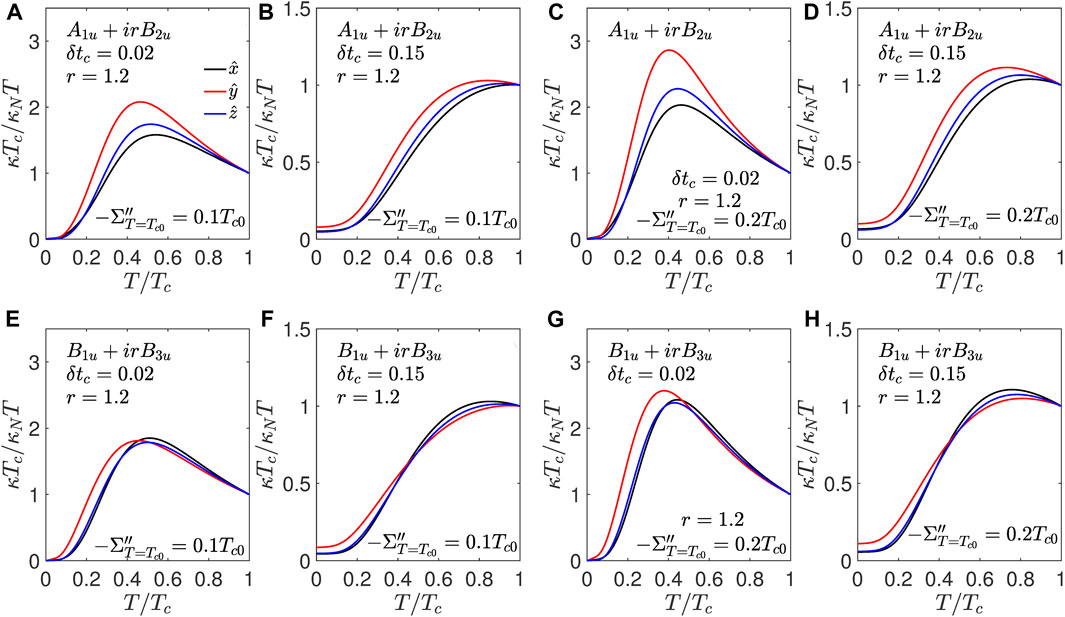
Figure 9. Effect of inelastic scattering: (A–D) show the temperature dependence of normalized thermal conductivity for the A1u + irB2u state for r = 1.2. (E–H) show the temperature dependence of the normalized thermal conductivity for the B1u + irB3u state. The imaginary part of the inelastic self energy at
4 Summary and concluding remarks
We studied low-energy quasiparticle excitations and thermal transport for the single-component and two-component pairing states allowed by the irreducible representations of the D2h point group symmetry, which is relevant for the orthorhombic UTe2 crystals. Since D2h has only one-dimensional representations, the four single-component pairing states corresponding to the irreducible representations cannot break the time-reversal symmetry and describe unitary triplet pairing states. Therefore, we also considered the pairing states that are combinations of two of the four irreducible representations using a single mixing parameter r. We examined all six two-component superconducting states as a function of r on a cylindrical Fermi surface, which describe either gapped states or states with spectral point nodes depending on the value of the mixing parameter. The spectral point nodes are not necessarily the zeros of order parameters, but they are the points on the Fermi surface hosting quasiparticle excitations. The spectral nodes are identical to the gap nodes in the case of single-component or unitary states. These six states can be divided into AF or FM categories depending on the Fermi surface average of the Cooper pair spin moment, which vanishes for the AF states and remains finite for the FM states. Except for the A1u + irB1u state, all other states are chiral on the cylindrical Fermi surface as the average angular momentum of the Cooper pairs remains finite.
After introducing the single-parameter model for the two-component states, we calculated the effect of impurity scattering within the self-consistent T-matrix approximation. One of the new findings is the spin-dependent impurity scattering rate for the chiral states. This happens due to finite quasiparticle spin densities for the chiral states. This can be interpreted as accumulation of magnetization near the impurity sites and this leads to qualitative changes in the quasiparticle excitation spectrum. For the two-component states, the nodes are accidental, not symmetry-imposed, like the single-component states, and the spin-dependent self-energy or the impurity-pinned magnetization can change the position of the spectral nodes. In principle, the removal of spectral point nodes by impurity scattering is possible in the chiral superconducting states, but we have not found such an effect for the cases that we considered. Next, we calculate the thermal conductivity using the Kubo formula for the thermal–current response function. Due to spin-dependent impurity self-energies, the thermal conductivity significantly differs from the thermal conductivity reported for the unitary states. We examine the thermal transport for all the single- and double-component states that are possible for the D2h point group.
We have considered a single band with a cylindrical Fermi surface in our theoretical calculations. The quantum oscillation experiment reports two cylindrical Fermi surfaces, where one is an electron-like and the other is a hole-like Fermi surface with comparable effective masses [35]. However, we expect our analysis to be valid for a two-band system as well because interband scattering is always pair-breaking due to odd-parity order parameters. The impurity will renormalize the quasiparticle energies, and there will not be any off-diagonal impurity self-energy. Therefore, multiple bands will lead to a higher impurity scattering rate; this should not affect the anisotropy of the thermal transport. There are also some speculations about a closed Fermi surface near the Z point; therefore, we also considered a spherical Fermi surface (see Supplementary Material). The key qualitative difference is the possibility of nodes along the
Based on our thermal transport study and some recent experimental data, we can identify some states that could possibly describe the gap structure in UTe2. Definitive conclusions are not possible at this time due to a lack of sufficient direction-dependent data on the newer samples, but we can make some qualitative statements and rule out some states. For the A1u + irB1u state on a cylindrical Fermi surface, the normalized thermal conductivity shows isotropic behavior as a function of impurity scattering in the zero-temperature limit and in its temperature dependence for a fixed disorder level. The limited data that are available for the thermal conductivity indicate weak in-plane anisotropy, but not absolute isotropic behavior [7]. The thermal conductivity measurements obtained by [34] claim a fully gapped superconducting state. In contrast, another independent thermal conductivity measurement obtained by Hayes et al. shows evidence for point nodes without finding any residual thermal conductivity in the zero-temperature limit [8]. Therefore, the absence of finite zero-temperature limit thermal conductivity in high-quality samples is not sufficient to rule out point nodes. Other probes such as the field dependence of specific heat suggest a superconducting state with nodes closer to the
As mentioned earlier, the phonon thermal conductivity could be significant, especially in the low Tc samples. At very low temperatures, the scattering of phonons from defects dictates the phonon mean free path, and hence the phonon thermal conductivity [37–39]. Phonon thermal conductivity is expected to be insignificant in the high-quality samples due to the low concentration of defects. Therefore, a systematic measurement of thermal conductivity along all three directions in the samples with high residual resistivity ratios is highly desirable. One common feature among all these superconducting phases is zero κ/T in the zero-temperature limit in clean samples. For sufficient disorder, even point nodal states acquire a very small residual κ/T, which would require very careful low-T measurements to detect.
Data availability statement
The original contributions presented in the study are included in the article/Supplementary Material; further inquiries can be directed to the corresponding authors.
Author contributions
VM: writing–original draft and writing–review and editing. GW: writing–original draft and writing–review and editing. PH: writing–original draft and writing–review and editing.
Funding
The author(s) declare that financial support was received for the research, authorship, and/or publication of this article. PH was supported by the NSF under DMR-2231821.
Acknowledgments
The authors thank S. Anlage, I. Hayes, T. Metz, J.P. Paglione, and T. Shibauchi for useful discussions.
Conflict of interest
The authors declare that the research was conducted in the absence of any commercial or financial relationships that could be construed as a potential conflict of interest.
Publisher’s note
All claims expressed in this article are solely those of the authors and do not necessarily represent those of their affiliated organizations, or those of the publisher, the editors, and the reviewers. Any product that may be evaluated in this article, or claim that may be made by its manufacturer, is not guaranteed or endorsed by the publisher.
Supplementary material
The Supplementary Material for this article can be found online at: https://www.frontiersin.org/articles/10.3389/fphy.2024.1397524/full#supplementary-material
References
1. Ran S, Eckberg C, Ding QP, Furukawa Y, Metz T, Saha SR, et al. Nearly ferromagnetic spin-triplet superconductivity. Science (2019) 365:684–7. doi:10.1126/science.aav8645
2. Aoki D, Ishida K, Flouquet J. Review of U-based ferromagnetic superconductors: comparison between UGe2, URhGe, and UCoGe. J Phys Soc Jpn (2019) 88:022001. doi:10.7566/JPSJ.88.022001
3. Aoki D, Brison JP, Flouquet J, Ishida K, Knebel G, Tokunaga Y, et al. Unconventional superconductivity in UTe2. J Phys Condensed Matter (2022) 34:243002. doi:10.1088/1361-648X/ac5863
4. Fujibayashi H, Nakamine G, Kinjo K, Kitagawa S, Ishida K, Tokunaga Y, et al. Superconducting order parameter in ute2 determined by knight shift measurement. J Phys Soc Jpn (2022) 91:043705. doi:10.7566/JPSJ.91.043705
5. Matsumura H, Fujibayashi H, Kinjo K, Kitagawa S, Ishida K, Tokunaga Y, et al. Large reduction in the a-axis knight shift on UTe2 with Tc = 2.1 k. J Phys Soc Jpn (2023) 92:063701. doi:10.7566/JPSJ.92.063701
6. Aoki D, Nakamura A, Honda F, Li D, Homma Y, Shimizu Y, et al. Unconventional superconductivity in heavy fermion ute2. J Phys Soc Jpn (2019) 88:043702. doi:10.7566/JPSJ.88.043702
7. Metz T, Bae S, Ran S, Liu IL, Eo YS, Fuhrman WT, et al. Point-node gap structure of the spin-triplet superconductor ute2. Phys Rev B (2019) 100:220504. doi:10.1103/PhysRevB.100.220504
8. Hayes IM, Metz TE, Frank CE, Saha SR, Butch NP, Mishra V, et al. Robust nodal behavior in the thermal conductivity of superconducting UTe2. arXiv:2402 (2024):19353. doi:10.48550/arXiv.2402.19353
9. Volovik GE, Gorkov LP. Superconducting classes in heavy-fermion systems. Zh Eksp Teor Fiz (1985) 88:1412–28.
10. Ueda K, Rice TM. p-wave superconductivity in cubic metals. Phys Rev B (1985) 31:7114–9. doi:10.1103/PhysRevB.31.7114
11. Blount EI. Symmetry properties of triplet superconductors. Phys Rev B (1985) 32:2935–44. doi:10.1103/PhysRevB.32.2935
12. Ran S, Liu IL, Eo YS, Campbell DJ, Neves PM, Fuhrman WT, et al. Extreme magnetic field-boosted superconductivity. Nat Phys (2019) 15:1250–4. doi:10.1038/s41567-019-0670-x
13. Wang Z, Rodriguez JO, Jiao L, Howard S, Graham M, Gu GD, et al. Evidence for dispersing 1D Majorana channels in an iron-based superconductor. Science (2020) 367:104–8. doi:10.1126/science.aaw8419
14. Kitaev AY. Unpaired majorana fermions in quantum wires. Physics-Uspekhi (2001) 44:131–6. doi:10.1070/1063-7869/44/10S/S29
16. Ivanov DA. Non-abelian statistics of half-quantum vortices in p-wave superconductors. Phys Rev Lett (2001) 86:268–71. doi:10.1103/PhysRevLett.86.268
17. Chung SB, Zhang HJ, Qi XL, Zhang SC. Topological superconducting phase and majorana fermions in half-metal/superconductor heterostructures. Phys Rev B (2011) 84:060510. doi:10.1103/PhysRevB.84.060510
18. Hayes IM, Wei DS, Metz T, Zhang J, Eo YS, Ran S, et al. Multicomponent superconducting order parameter in UTe2. Science (2021) 373:797–801. doi:10.1126/science.abb0272
19. Rosa PFS, Weiland A, Fender SS, Scott BL, Ronning F, Thompson JD, et al. Single thermodynamic transition at 2 k in superconducting UTe2 single crystals. Commun Mater (2022) 3:33. doi:10.1038/s43246-022-00254-2
20. Sakai H, Opletal P, Tokiwa Y, Yamamoto E, Tokunaga Y, Kambe S, et al. Single crystal growth of superconducting ute2 by molten salt flux method. Phys Rev Mater (2022) 6:073401. doi:10.1103/PhysRevMaterials.6.073401
21. Ajeesh MO, Bordelon M, Girod C, Mishra S, Ronning F, Bauer ED, et al. The fate of time-reversal symmetry breaking in UTe2. Phys. Rev. X (2023) 13:041019. doi:10.1103/PhysRevX.13.041019
22. Azari N, Yakovlev M, Rye N, Dunsiger SR, Sundar S, Bordelon MM, et al. Absence of Spontaneous magnetic fields due to time-reversal symmetry breaking in Bulk superconducting UTe2. Phys. Rev. Lett. (2023) 131:226504. doi:10.1103/PhysRevLett.131.226504
23. Theuss F, Shragai A, Grissonnanche G, Hayes IM, Saha SR, Eo YS, et al. Single-component superconductivity in UTe2 at ambient pressure. Nat. Phys. (2024). doi:10.1038/s41567-024-02493-1
24. Ambegaokar V, Griffin A. Theory of the thermal conductivity of superconducting alloys with paramagnetic impurities. Phys Rev (1965) 137:A1151–67. doi:10.1103/PhysRev.137.A1151
25. Kadanoff LP, Martin PC. Hydrodynamic equations and correlation functions. Ann Phys (1963) 24:419–69. doi:10.1016/0003-4916(63)90078-2
26. Schmitt-Rink S, Miyake K, Varma CM. Transport and thermal properties of heavy-fermion superconductors: a unified picture. Phys Rev Lett (1986) 57:2575–8. doi:10.1103/PhysRevLett.57.2575
27. Hirschfeld P, Vollhardt D, Wölfle P. Resonant impurity scattering in heavy fermion superconductors. Solid State Commun (1986) 59:111–5. doi:10.1016/0038-1098(86)90190-0
28. Hirschfeld PJ, Wölfle P, Einzel D. Consequences of resonant impurity scattering in anisotropic superconductors: thermal and spin relaxation properties. Phys Rev B (1988) 37:83–97. doi:10.1103/PhysRevB.37.83
29. Ishihara K, Roppongi M, Kobayashi M, Imamura K, Mizukami Y, Sakai H, et al. Chiral superconductivity in UTe2 probed by anisotropic low-energy excitations. Nat Commun (2023) 14:2966. doi:10.1038/s41467-023-38688-y
30. Marchenko VI. On the theory of gauge symmetry of superconductors. Zh Eksp Teor Fiz (1986) 93:583–9.
31. Sigrist M, Rice TM. Symmetry classification of states in high temperature superconductors. Z Phys B (1987) 68:9–14. doi:10.1007/BF01307857
32. Annett JF. Symmetry of the order parameter for high-temperature superconductivity. Adv Phys (1990) 39:83–126. doi:10.1080/00018739000101481
33. Fledderjohann A, Hirschfeld P. Thermal conductivity anisotropy in superconducting UPt3. Solid State Commun (1995) 94:163–7. doi:10.1016/0038-1098(95)00050-X
34. Suetsugu S, Shimomura M, Kamimura M, Asaba T, Asaeda H, Kosuge Y, et al. Fully gapped pairing state in spin-triplet superconductor UTe2. Sci Adv. (2024) 10: eadk3772. doi:10.1126/sciadv.adk3772
35. Aoki D, Sakai H, Opletal P, Tokiwa Y, Ishizuka J, Yanase Y, et al. First observation of the de haas–van alphen effect and fermi surfaces in the unconventional superconductor UTe2. J Phys Soc Jpn (2022) 91:083704. doi:10.7566/JPSJ.91.083704
36. Lee S, Woods AJ, Rosa PFS, Thomas SM, Bauer ED, Lin SZ, et al. Anisotropic field-induced changes in the superconducting order parameter of ute2. arXiv:2310.04938. (2023). doi:10.48550/arXiv.2310.04938
37. Klemens PG. The scattering of low-frequency lattice waves by static imperfections. Proc Phys Soc London, Sect A (1955) 68:1113–28. doi:10.1088/0370-1298/68/12/303
38. Bardeen J, Rickayzen G, Tewordt L. Theory of the thermal conductivity of superconductors. Phys Rev (1959) 113:982–94. doi:10.1103/PhysRev.113.982
Keywords: triplet superconductors, thermal transport, impurity scattering, nonunitary pairing, unitary pairing
Citation: Mishra V, Wang G and Hirschfeld PJ (2024) Thermal conductivity of nonunitary triplet superconductors: application to UTe2. Front. Phys. 12:1397524. doi: 10.3389/fphy.2024.1397524
Received: 07 March 2024; Accepted: 22 April 2024;
Published: 19 June 2024.
Edited by:
Dimosthenis Stamopoulos, National and Kapodistrian University of Athens, GreeceReviewed by:
Övgü Ceyda Yelgel, Recep Tayyip Erdoğan University, TürkiyePanagiotis Kotetes, Chinese Academy of Sciences (CAS), China
Yi-feng Yang, Chinese Academy of Sciences (CAS), China
Copyright © 2024 Mishra, Wang and Hirschfeld. This is an open-access article distributed under the terms of the Creative Commons Attribution License (CC BY). The use, distribution or reproduction in other forums is permitted, provided the original author(s) and the copyright owner(s) are credited and that the original publication in this journal is cited, in accordance with accepted academic practice. No use, distribution or reproduction is permitted which does not comply with these terms.
*Correspondence: Vivek Mishra, dml2ZWttLnBoeXNAZ21haWwuY29t; P. J. Hirschfeld, cGpoQHBoeXMudWZsLmVkdQ==
 Vivek Mishra
Vivek Mishra Ge Wang
Ge Wang P. J. Hirschfeld
P. J. Hirschfeld